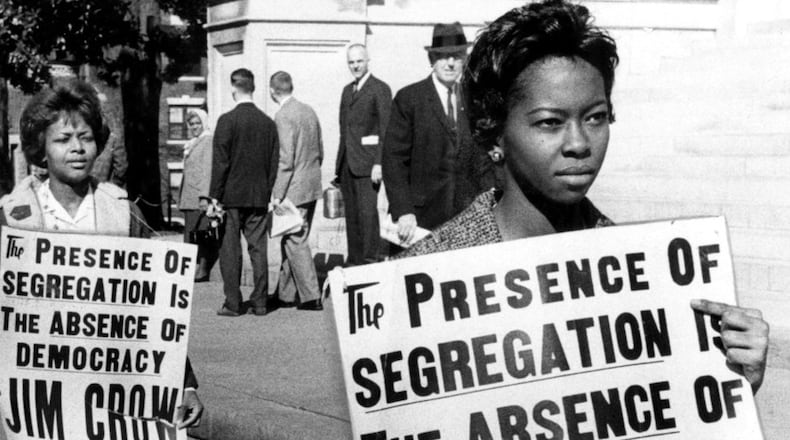In 1970, Black people made up 21% of the metro Atlanta population. They were concentrated in a swath of land east and west of downtown.
White residents comprised 76% of the population. They lived throughout the 10-county metro region except in areas with high concentrations of Blacks.
About 32,000 Hispanic residents comprised 2% of the population and there were no reported Asian residents.
Fast-forward to 2020 and the metro area looks a lot more diverse but only a little less segregated, according to a recent survey from Georgia State University’s Center for State and Local Finance.
David Sjoquist, a professor of economics who authored the paper with Lakshimi Pandey, has lived in Atlanta since 1970. He said he was surprised by patterns on the dot maps they created which showed the Black and white populations of 10 counties in metro Atlanta by decade from 1970 to 2020.
“I was unaware of how much the racial composition had changed outside the city of Atlanta, particularly on the north side,” said Sjoquist. “I knew the south side was predominantly Black.” From 1970 on, the Black population moved southwest then southeast then further south into Clayton County, Sjoquist said. He had thought of certain areas like Fayette County and Rockdale County as being white suburbs but both have changed, he said.
When I moved from the melting pot of New York to Atlanta in 2006, I was struck by the way conversations about race in this city always seemed to be framed in black and white. After I read Sjoquist’s report on the racial composition of the city’s population, I finally understood the basis for that feeling.
It wasn’t until 2000 that other racial groups began to root themselves in metro Atlanta in larger numbers, according to Sjoquist’s research.
In 2020, Asian residents comprised 7% of the metro area population and Hispanic residents comprised 13%. Asians account for a large segment of the population growth among minority races in metro Atlanta, according to the study, as well as the increasing number of individuals who self-define as biracial or multiracial.
According to a national study on neighborhood segregation from Brookings Institution, part of what compels some people of other races to move to an area is a lower level of segregation.
The passage of the Fair Housing Act in 1968 helped curtail restrictive housing policies and boosted the presence of racial minorities in metro Atlanta. But despite increased diversity, particularly the growth of the Hispanic and Asian populations, at the neighborhood level, segregation persists.
In metro Atlanta, the dissimilarity index, the extent to which two groups are unequally spread across neighborhoods, remains high for most races. The index can range from zero (complete integration) to 100 (the percent of one group that would need to move to be evenly distributed across neighborhoods with the other group). An index below 30% is considered well integrated while an index above 60% indicates a highly segregated area.
To achieve full integration with white residents, 50% to 60% of Black and Asian residents in Atlanta would have to move and 40% to 50% of Hispanic residents would have to move, according to Brookings data from 2015 to 2019. White residents — even in the most diverse metro areas of the U.S. — continue to live in mostly white neighborhoods.
The dissimilarity index is particularly high for Black residents living in DeKalb and Fulton counties, according to Sjoquist’s research. Both counties have a dissimilarity index of 70%, which means that 70% of Black residents in those counties would have to move in order to be fully integrated with their white neighbors.
Over the decades, there have been a number of theories to explain why neighborhoods are not more integrated. One is that Black people like to live with other Black people. But Sjoquist found that is not supported by historical data.
In 2020, 47% of Black residents lived in neighborhoods with a Black population of 67% or more, but most of the increase in Atlanta’s Black population has occurred in census tracts with a small number of Black people.
Another theory is that residents segregate by income and if there are large racial differences in income distribution then it naturally leads to more racial segregation.
If that were true, researchers would expect the Black population to be greater in neighborhoods where the average income of Black residents is low, but the study found no such correlation.
The study did support the hypothesis that white people prefer to live in white neighborhoods — resulting in the white flight that occurred in Atlanta and other metropolitan areas for decades.
But that dynamic began to shift in 2000, suggesting that white residents are somewhat more comfortable living in neighborhoods with Black people than in prior decades, Sjoquist said.
Between 2010 and 2020, the number of whites living in neighborhoods that are more than two-thirds Black increased, according to survey findings. While Sjoquist’s study doesn’t measure causation, he said they are looking more closely at possible factors such as gentrification and the amount of available housing in neighborhoods where Black residents are moving out as white residents move in.
Research has consistently shown that racial residential segregation is the result of federal and local policies as well as housing and mortgage market discrimination. The Fair Housing Act has helped create more integrated neighborhoods in metro Atlanta, but policies can only do so much.
Metro Atlanta is increasingly diverse and neighborhoods should reflect those changes in the population.
If diverse neighborhoods are important to us, we have to be more intentional about making that a priority in choosing where we live.
Read more on the Real Life blog (www.ajc.com/opinion/real-life-blog/) and find Nedra on Facebook (www.facebook.com/AJCRealLifeColumn) and Twitter (@nrhoneajc) or email her at nedra.rhone@ajc.com.
About the Author
Keep Reading
The Latest
Featured



